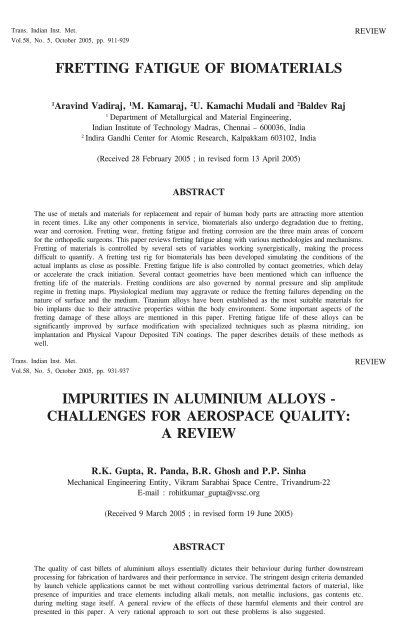Vol.58, No. 5 - Indira Gandhi Centre for Atomic Research
Vol.58, No. 5 - Indira Gandhi Centre for Atomic Research
Vol.58, No. 5 - Indira Gandhi Centre for Atomic Research
Create successful ePaper yourself
Turn your PDF publications into a flip-book with our unique Google optimized e-Paper software.
Trans. Indian Inst. Met.<br />
<strong>Vol.58</strong>, <strong>No</strong>. 5, October 2005, pp. 911-929<br />
REVIEW<br />
FRETTING FATIGUE OF BIOMATERIALS<br />
1<br />
Aravind Vadiraj, 1 M. Kamaraj, 2 U. Kamachi Mudali and 2 Baldev Raj<br />
1<br />
Department of Metallurgical and Material Engineering,<br />
Indian Institute of Technology Madras, Chennai – 600036, India<br />
2<br />
<strong>Indira</strong> <strong>Gandhi</strong> Center <strong>for</strong> <strong>Atomic</strong> <strong>Research</strong>, Kalpakkam 603102, India<br />
(Received 28 February 2005 ; in revised <strong>for</strong>m 13 April 2005)<br />
ABSTRACT<br />
The use of metals and materials <strong>for</strong> replacement and repair of human body parts are attracting more attention<br />
in recent times. Like any other components in service, biomaterials also undergo degradation due to fretting,<br />
wear and corrosion. Fretting wear, fretting fatigue and fretting corrosion are the three main areas of concern<br />
<strong>for</strong> the orthopedic surgeons. This paper reviews fretting fatigue along with various methodologies and mechanisms.<br />
Fretting of materials is controlled by several sets of variables working synergistically, making the process<br />
difficult to quantify. A fretting test rig <strong>for</strong> biomaterials has been developed simulating the conditions of the<br />
actual implants as close as possible. Fretting fatigue life is also controlled by contact geometries, which delay<br />
or accelerate the crack initiation. Several contact geometries have been mentioned which can influence the<br />
fretting life of the materials. Fretting conditions are also governed by normal pressure and slip amplitude<br />
regime in fretting maps. Physiological medium may aggravate or reduce the fretting failures depending on the<br />
nature of surface and the medium. Titanium alloys have been established as the most suitable materials <strong>for</strong><br />
bio implants due to their attractive properties within the body environment. Some important aspects of the<br />
fretting damage of these alloys are mentioned in this paper. Fretting fatigue life of these alloys can be<br />
significantly improved by surface modification with specialized techniques such as plasma nitriding, ion<br />
implantation and Physical Vapour Deposited TiN coatings. The paper describes details of these methods as<br />
well.<br />
Trans. Indian Inst. Met.<br />
<strong>Vol.58</strong>, <strong>No</strong>. 5, October 2005, pp. 931-937<br />
REVIEW<br />
IMPURITIES IN ALUMINIUM ALLOYS -<br />
CHALLENGES FOR AEROSPACE QUALITY:<br />
A REVIEW<br />
R.K. Gupta, R. Panda, B.R. Ghosh and P.P. Sinha<br />
Mechanical Engineering Entity, Vikram Sarabhai Space <strong>Centre</strong>, Trivandrum-22<br />
E-mail : rohitkumar_gupta@vssc.org<br />
(Received 9 March 2005 ; in revised <strong>for</strong>m 19 June 2005)<br />
ABSTRACT<br />
The quality of cast billets of aluminium alloys essentially dictates their behaviour during further downstream<br />
processing <strong>for</strong> fabrication of hardwares and their per<strong>for</strong>mance in service. The stringent design criteria demanded<br />
by launch vehicle applications cannot be met without controlling various detrimental factors of material, like<br />
presence of impurities and trace elements including alkali metals, non metallic inclusions, gas contents etc.<br />
during melting stage itself. A general review of the effects of these harmful elements and their control are<br />
presented in this paper. A very rational approach to sort out these problems is also suggested.
















